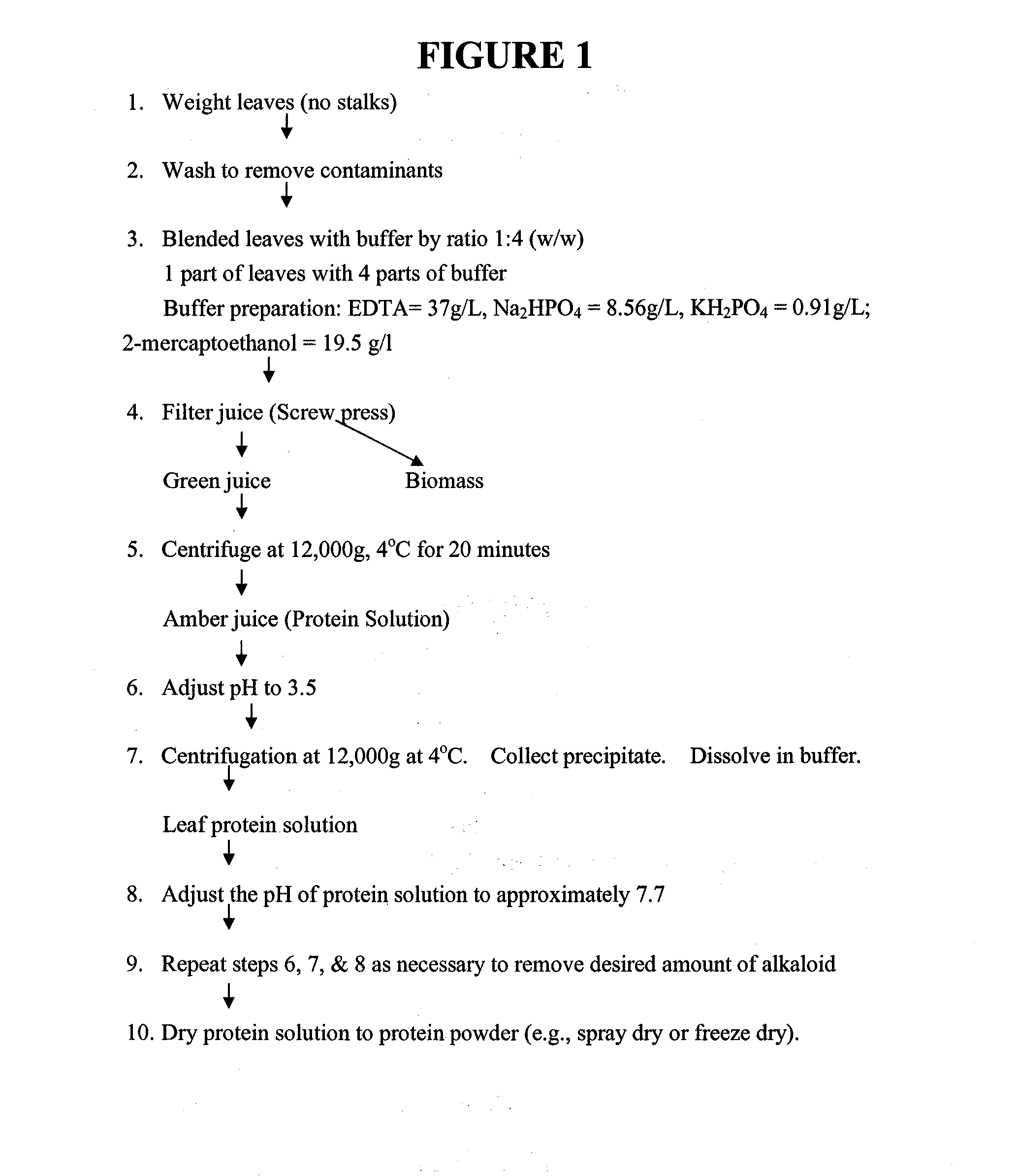Methods for removing nicotine and other alkaloids from soluble leaf proteins in solanaceous and other plant species
a technology of plant proteins and nicotine, which is applied in the direction of plant/algae/fungi/lichens, immunoglobulins, peptides, etc., can solve the problems of environmental compliance issues, limit the use of leaf proteins, and use of solvents and particularly expensive supercritical solvents, so as to maximize the solubility of leaf proteins and accelerate separation
- Summary
- Abstract
- Description
- Claims
- Application Information
AI Technical Summary
Benefits of technology
Problems solved by technology
Method used
Image
Examples
example 1
[0041]The inventors evaluated three different approaches for removing nicotine from tobacco-derived soluble leaf proteins. In each case, the evaluations utilized an “amber juice” solution comprising water-soluble leaf protein prepared according to the method of Lo, et al. (2008) WO / 2008 / 143914. The samples were derived from Maryland tobacco variety 609LA, a low-alkalkoid variety containing 0.6 mg / g to 0.8 mg / g of nicotine.
[0042]In the first approach, acetone (10 ml, Sigma Aldrich) stored at −20° C. was added to an amber juice leaf protein solution (10 ml) with continuous stirring, until the protein started to precipitate, followed by centrifuged at 12,000×g for 10 min at 4° C. The precipitate was collected to further assay nicotine content and soluble protein content.
[0043]In the second treatment, a Prep / Scale TFF ultrafiltration module containing polysulfone membrane (100,000 Da MWCO) (Millipore, Bedford, Mass.) was employed to reduce the nicotine content of the tobacco protein sol...
example 2
[0052]We conducted a separate test, to measure total alkaloids using a continuous flow analyzer. The purpose of this example was to measure the content of all alkaloids in the treated samples, and not merely nicotine. We tested two treated samples. One sample had been treated using the acetone treatment, while the second sample had been treated using the triple replication of the protein precipitation with phosphoric acids. The Quantification Limit=0.01% of dry matter. The results are shown in Table 3.
TABLE 3Total Alkaloid AnalysisPhosphoric AcidAcetone(triple replication treatment)Total AlkaloidsBQLBQLBQL = below quantification limit
[0053]In each case, we found the total alkaloid level to be below the quantitation limit on a 0.01% of dry matter basis. This result demonstrated that the phosphoric acid treatment (performed three times) resulted in removal of all alkaloids from the leaf protein and not merely nicotine.
PUM
| Property | Measurement | Unit |
|---|---|---|
| Fraction | aaaaa | aaaaa |
| Mass | aaaaa | aaaaa |
| Density | aaaaa | aaaaa |
Abstract
Description
Claims
Application Information
 Login to View More
Login to View More - R&D
- Intellectual Property
- Life Sciences
- Materials
- Tech Scout
- Unparalleled Data Quality
- Higher Quality Content
- 60% Fewer Hallucinations
Browse by: Latest US Patents, China's latest patents, Technical Efficacy Thesaurus, Application Domain, Technology Topic, Popular Technical Reports.
© 2025 PatSnap. All rights reserved.Legal|Privacy policy|Modern Slavery Act Transparency Statement|Sitemap|About US| Contact US: help@patsnap.com


